Getting the most from food and drink branding: A guide
In recent years, food packaging and marketing have evolved rapidly, and the food and beverage industry has seen an incredible boom, becoming increasingly rich, diverse, and competitive as markets have become more global.
The food industry encompasses a diverse range of businesses, from food manufacturers, nutritionists and retailers to restaurants, food bloggers, wholesalers, food regulators and so on. And that’s just to name a few – these food-related services are just the tip of the iceberg.
Increasingly, brands are beginning to recognise the power of branding and – with the help of branding and design agencies – are harnessing the power of design to help them excite, entice and engage their customers.
Having a unique and appealing brand is the foundation of every successful food business – which is why branding is so important. A successful food brand’s brand identity is driven by its uniqueness, appeal, and well-conceived marketing strategy. In the food and drink sector, packaging design is often the first point of contact a customer has with you and your products, meaning your branding can make or break a customer’s decision.
We’ve put together this guide so that you have everything you need to get you started on your branding journey – let’s get into it.
What is the purpose of a food & drink brand?
Food delivery services, independent cafes, global restaurants, beer breweries, and supermarkets all have one purpose: to serve their customers and secure their place in the market.
Just like any other brand, a food or beverage brand establishes an identity among its customers. A successful brand not only offers a quality product with excellent customer service and packaging but also creates an emotional connection with its customers. Branding is all about making it easy for consumers to relate to your brand and the foods and beverages you offer – so that when it’s between you or another business, they’re more likely to choose you.
There is an increasing awareness among consumers about how their consumption affects their health and the environment. To keep their customers, brands must think about their products from both angles – which is where a strong brand strategy comes into play.
Strong branding not only communicates your message and sparks customer connections, but it differentiates you in crowded markets and sets you apart as a desirable and unique brand. When it comes to influencing customers’ decisions, branding is everything.
What is the difference between branding and labelling?
The branding process is all about creating an overall identity for your brand and shaping the perception of its products and services. The goal is to evoke emotion and create a connection between consumers and a product by encapsulating its values and messaging.
The purpose of labelling is more functional. It describes the specific features, capabilities, and information about your products. Ultimately, labelling focuses on facts. It may list your ingredients, nutritional information, or instructions for example.
Defining your strategy
As with any branding project, there are a few things to consider before starting the process. It is important to determine the core of your business before embarking on the creative process by asking yourself the following:
- Who is buying your product? Identify your target market and discover their likes, dislikes, desires, and pain points. The more you know about them, the stronger your branding will be. Ask yourself: are they sustainability focussed, parents or teenagers? Is their income flexible or are they on a strict budget? To effectively brand your business, you must put your customer at the heart and tailor everything from your packaging and print design to your web design to appeal to them.
- How do you describe your brand? How would your company speak, talk, and act if it were a person? The tone of voice and character of your brand should be crafted using adjectives that express your brand’s personality.
- What makes your brand unique? How are you different from your competitors? What is your unique selling point? Identifying your most appealing features and highlighting your strengths is crucial to successful branding.
- What is your story? Although your product is important, consumers want to know who you are and what your company stands for. It may be that your food and beverage brand is driven by your personality, a lifestyle statement, or by your ethical stance. No matter what your story is, share it across your channels and embed it across your marketing – your brand story should drive everything you do.
Developing a successful food and beverage Brand
No matter where you are in the process of starting a new food and beverage business, or if you’re already operating a business in the industry, branding should be a top priority. To build a successful brand, every company should focus on the following:
- Market research: Regardless of your product, you will always face competition. Establish your brand’s position and determine how you can differentiate yourself. What makes you authentic? What makes you unique? Do you offer exclusive, premium, or affordable and accessible products? How do you compare to the competition?
- Brand messaging: What does your brand have to say? From your brand name, to your copywriting and strapline – your messaging should uphold your brand’s values, beliefs, and mission statement. With simple brand modelling tools, you can work on defining your brand’s vision, to ensure consistency in tone and styling.
- Logo: This is the face of your brand and is at the core of your product branding strategy. Using your logo as the visual anchor for everything your brand represents can help you communicate your brand’s vision, purpose, and values. A strong logo design promotes brand recall and is what customers will come to visually associate with your brand, food products, and brand experience.
- Packaging: When it comes to food branding, the packaging is vital, and it carries a great deal of responsibility. Depending on its quality, it can either attract or alienate customers and on a literal level, it preserves the quality of your product. Your packaging design must reflect your brand’s purpose, as well as the culinary experience of your products. No matter who you’re selling to – consumers, chefs, or caterers – everyone likes a well-packaged product, so make sure it looks good and works well.Consider your target audience’s tastes when choosing packaging materials: Are they environmentally aware, cash-conscious, or might the product leak or need support the food or beverage? You should also carefully consider your graphic design elements and your choice of colours, fonts, and graphic shapes – all of which should complement the culinary elements of your product, appeal to the customers and grab attention for the right reasons.
- Partner up: Search the foodie world and build relationships with potential buyers, influencers, and food and drink marketing experts. Be on the lookout for people you want to work with, who share your values, who understand your brand, who you trust, and most importantly, which consultancy you can bring on board when it comes to food and drink packaging, PR, advertising and social media.
- Digital presence: Utilise social media and online sales to reach your audience and expand your influence. E-commerce solutions allow you to earn more and appeal to the flexible needs of customers. Ensure your brand’s representation is consistent across all channels to maintain a cohesive image.
Three brand identities that rise above the rest
How important is it for a brand to have a flexible identity? It’s vital – for a brand to succeed, it must have a strong brand identity – one that sets it apart from the rest. Here are some brands that get it right:
- BrewDog: This punk drink startup wasted no time making its mark on the business world. From brewing beer in the bottom of the North Sea to controversially bottling beer in taxidermy squirrels, their marketing campaigns helped kick-start a craft beer revolution. In response to current concerns over climate change, BrewDog launched a campaign, ‘BrewDog Tomorrow Commitment,’ focused on ensuring that ‘there is a planet on which we can brew beer.’ The company doesn’t shy away from being playful or rocking the boat, and has built a loyal customer base that relishes their products and initiatives.
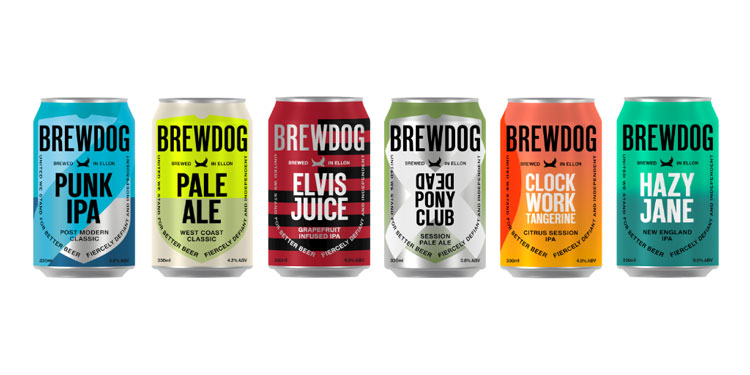
Image: Line up of cans: https://www.designweek.co.uk/issues/3-9-february-2020/brewdog-new-identity/
- Subway: There is no doubt that Subway has earned a loyal following of customers who are dedicated to the Subway experience. Their social media accounts allow Subway to flex its brand personality and showcase their visual branding. Featuring colourful, eye-catching imagery, images of tasty food, and playful flair, their visual brand identity grabs the attention of consumers, captures their brand personality – and most importantly highlights their product.
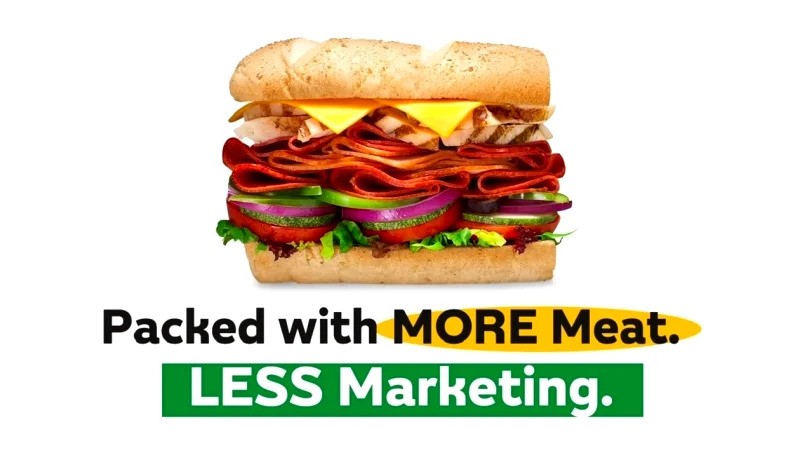
- Teapigs: Sustainability, fair wages, and partnering with NGOs are at the heart of Teapigs’ mission-driven brand. In addition to demonstrating their products, their blog content expresses their brand values, attracts new site visitors, educates readers about premium teas, and convinces tea enthusiasts why teapigs should be their brand of choice. But that’s not all they do. They put their money where their mouth is when it comes to their brand values, as they regularly publish content about their nonprofit partners, sustainability efforts, and fundraising initiatives.
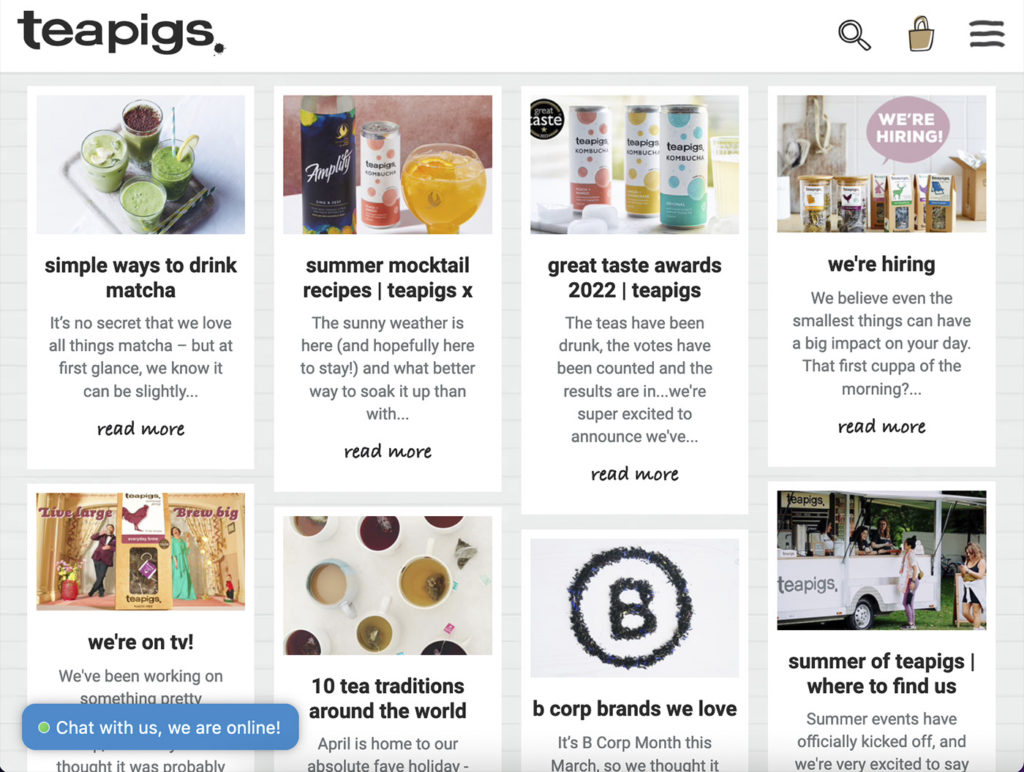
Teapigs blog. Image credits: https://www.teapigs.co.uk/blogs/news
Three rebrands that made an impact
Even the most beloved brands must change to stay relevant. In fast-moving markets, rebranding can reinvigorate food and drink brands. Here are some examples:
- Pringles: With a new logo, font, and packaging, Pringles redesigned its design after 20 years. The brand chose to simplify and modernise its design while maintaining the iconic look of Mr Pringle. The Pringle’s wordmark replaces Mr Pringle’s red bowtie – presenting a cleaner, simpler, more youthful, and more eye-catching alternative.
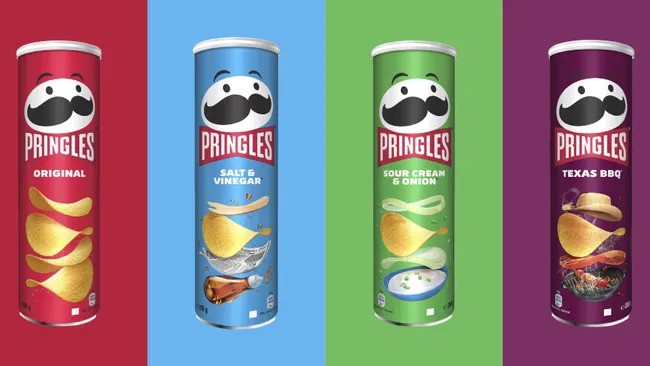
Pringles cans. Image credits: https://www.pringles.com/us/products/all.html
- McDonald’s: Design matters at McDonald’s: Their 2021 minimalist rebrand proves it. Moving away from simple white and red designs, McDonalds adopted simple shapes, bold colours and sleek new typography to display items’ names on their packaging and boxes. The rebrand infuse a sense of playfulness into their products, and while the rest of McDonald’s marketing campaigns have stayed the same, their localised rebrand proves that a complete brand overhaul isn’t always necessary – even the simplest of changes can make a big difference.
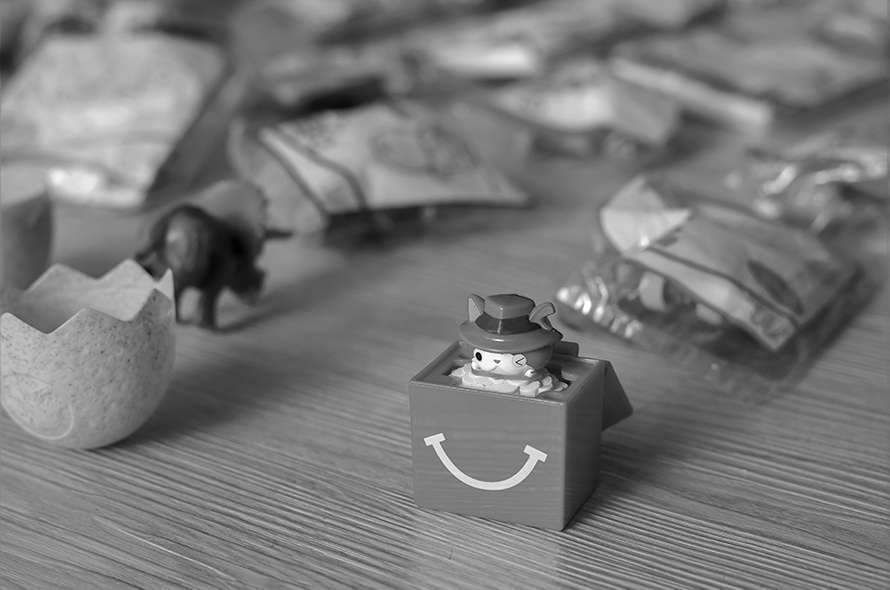
Mac Donald’s packaging. Image credits: https://medium.com/@McDonaldsCorp/continuing-our-journey-toward-sustainable-packaging-4415f621148
- Guinness: Bringing a 300-year-old brand into the 21st century can’t be easy, but Guinness managed it with two clear methods: an intense social media campaign and an updated logo. In addition to improving their logo and applying techniques learned from making iconic television commercials to their social-first ads, they brought the entire brand into the modern age while staying true to their roots.
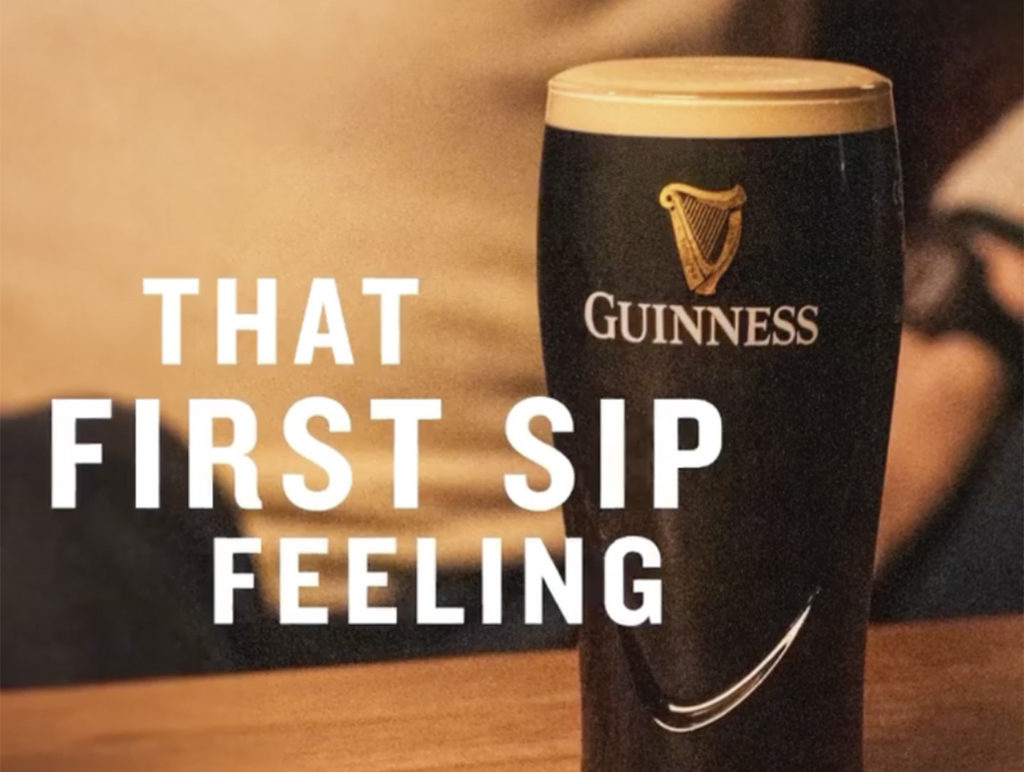
Guinness. Image credits: https://www.instagram.com/guinness/?hl=en
Start your food and drink product journey
The best food and drink packaging not only looks the part – but is functional too.
As a full-service branding agency, we offer a comprehensive approach to new brands, e-commerce businesses, and leading retailers alike, and we take pride in creating visual identities that enable brands to grow and prosper. You can discover more about our work and services here website.
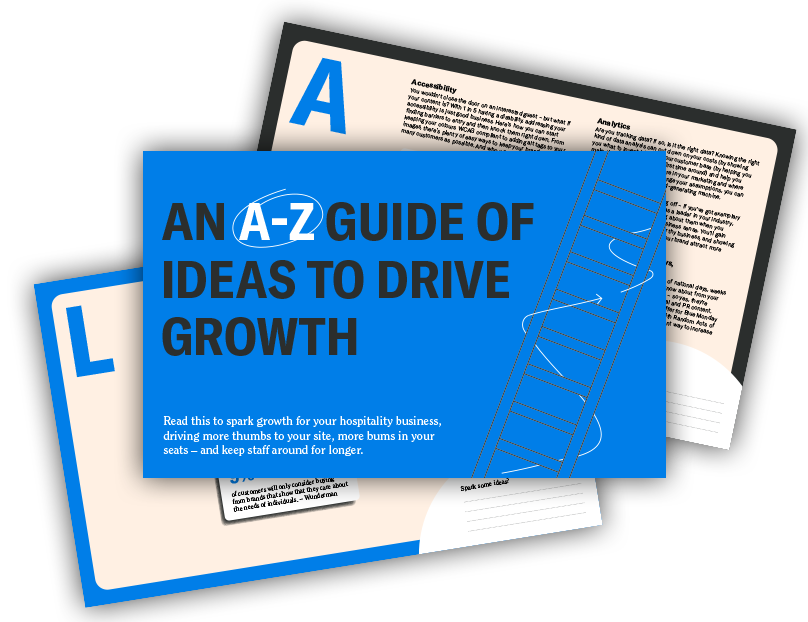
Looking to increase your hospitality brand's reach? Download our free A-Z guide to grow your brand.
Download guide